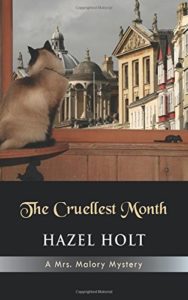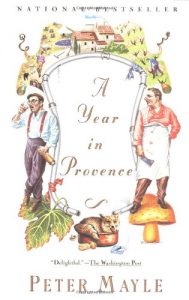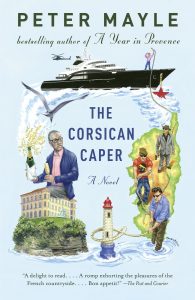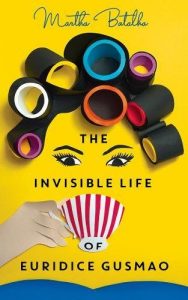Mrs. Malory (or is it Mallory?) by Hazel Holt
Once upon a time, there was a bookstore dedicated solely to mysteries ~~ called the San Francisco Mystery Bookstore.
It was a dusty old place, with a chain-smoking, sometimes surly owner who would only glance up from her own reading to give a visiting dog a treat or if you asked a question. Once engaged, she could deftly suggest your next perfect mystery read based on your interests and tastes. (Good bookstore people share this skill.)
The bus at our corner would take me directly to the shop, where I would browse away many a foggy afternoon. It had mismatched shelving, small nooks with chairs, a creaky wooden floor, with the books arranged in the owner’s unique method. There were separate sections for historical mysteries, true crime, British crime, and even mysteries set in San Francisco. In short, it was a local treasure and one of my favorite places. Sadly this small, independent bookseller closed their doors in 2011, a victim of skyrocketing rent and the demise of small independent bookstores. (I guess my purchases weren’t enough to carry this little store, despite Husband’s theories to the contrary.)
It was at this quaint bookshop that I was steered towards the Mrs. Malory series after confessing my love for Agatha Raisin.
Hazel Holt wrote an entire series featuring Sheila Malory, a middle-aged widow, Siamese cat owner, tireless volunteer, and snoop in the sleepy English village of Taviscombe –a modern-day Miss Marple.
This is a veddy veddy British series, filled with English villagers, non-stop teas, old country estates, horses, and gentle humor. The rich descriptions transport the reader right into the middle of these delightful scenes. At first, these short little mysteries may seem obvious, but stay on your toes readers, as Ms. Holt cleverly deals out potential culprits, plots that twist around, and the murderer is often a surprise.
 The first in the series is Mrs. Malory Investigates and my early 1989 St. Martin’s Press edition has the Malory misspelled as “Mallory” throughout the text. The later edition, published under the title of Gone Away has this content error corrected.
The first in the series is Mrs. Malory Investigates and my early 1989 St. Martin’s Press edition has the Malory misspelled as “Mallory” throughout the text. The later edition, published under the title of Gone Away has this content error corrected.
 The second in the series The Cruellest Month is set at Oxford’s Bodleian Library, where Ms. Holt (no slouch) once taught.
The second in the series The Cruellest Month is set at Oxford’s Bodleian Library, where Ms. Holt (no slouch) once taught.
Turns out the author was quite the intellectual and a good friend of Barbara Pym. Ms. Holt even wrote her biography and completed one of Pym’s unfinished novels. These British authors seemed to run around in the same small circles sharing tea and scones, and probably stealing each other’s plot ideas.
Sadly Ms. Holt died in 2015, so the complete series ends after 21 mysteries. I recommend you seek out these little gems –you’ll find yourself happily whiling away an evening, turning the pages.
Click HERE to find your own little local independent bookstore to try and keep in business.
Lillian Boxfish Takes a Walk by Kathleen Rooney
 Sometimes a book cries out, nay screams, to be read. Thus was the case with Lillian Boxfish Takes a Walk.
Sometimes a book cries out, nay screams, to be read. Thus was the case with Lillian Boxfish Takes a Walk.
Early in 2017, the publishers sent me a digital advanced reading copy, then one of my Book Barmy followers wrote me urging me to read it, also Powell’s Bookstore named it one of the best books of 2017, and finally — surprise! A brand new hardback copy arrived from my friend Peter as a New Year’s gift. And here dear readers — here is the clincher:
I really do think you’ll enjoy it. It’s beautifully written . . . witty, pithy, upliftingly sad in a weird way. Lillian is someone you want to take to lunch and drink lots of manhattans.
(the note from Peter, my smart, literate friend and Book Barmy follower.)
So I sat myself down, pushed all my other books aside and opened up Lillian Boxfish. And Peter was right, because by page 15, Lillian had become one of my favorite characters… But I’m getting ahead of myself.
Let’s start again shall we?
It’s New Year’s Eve 1984 and 85-year-old Lillian Boxfish is about to take a walk — a long walk. But first, she applies Helena Rubinstein’s Orange Fire lipstick (long ago discontinued-she stocked up), dons her beautiful, forty-year-old fur coat (still a classic) and a pulls on a pair of boots (sensible but stylish). Lillian then takes to the streets of New York, she has planned a long walk, an adventure really, to mark the end of the year — Domenico’s for a do-over on a dinner that ended badly years ago.
She leaves her beloved Murray Hill apartment, where she has lived alone for most of her life,
Alone, but not lonely; in the state of being solitary but not the condition of wishing myself otherwise. Solitude enrobed me like a long, warm coat.
That is the crux of this character-driven novel. Lillian walks (and walks, and walks) through New York City while reflecting on her life. The novel shifts seamlessly between past and present tense unified by Lillian’s witty voice.
Lillian recalls her days as an advertising copywriter and the inner-workings of Macy’s in the 1930’s. Fascinating, as she became one of the highest paid women in advertising. She specialized in humorous jingles and dabbles with poetry on the side. But, she couldn’t avoid the challenges of a career woman in a man’s world.
After falling for and marrying her true love, Max, she becomes pregnant and Macy’s management, like all male-dominated corporations at the time, forces her to quit her career. Lillian does her best to adapt to the stifling role of housewife and mother to their son Johnny, she has some of her poetry published, and does some freelance advertising work — but soon the marriage starts to crumble and so does Lillian.
All these bittersweet reminiscences take place while Lillian continues her walk in late night New York. Her observations of New York City are a tribute to her love for the city throughout her life. There is danger in the air as she walks — this is just after the subway vigilante killings — and everyone she meets is concerned for her safety. But our Lillian cares not. She wants, no needs, to walk. She is strong and fit, still walking miles around the city most days. She especially needs to walk this last night of 1984 ~~she even has a name for it ~~ Solvitur ambulando: It is solved by walking.
As we walk with Lillian we are part of her musings ~~
On the changes in advertising:
Given that the majority of communication to which we are subjected in a day consists of advertising, if nearly all of that advertising insists on regarding us as pampered children, what does that do to us?
And how fame has doomed true character:
People who command respect are never as widely known as people who command attention.
But Lillian is not a grumbler, she has core values worth emulating:
…my true religion is actually civility. Please note that I do not call my faith ‘politeness’. That’s part of it, yes, but I say ‘civility’ because I believe that good manners are essential to the preservation of humanity — one’s own and others’ — but only to the extend that civility is honest and reasonable, not merely the mindless handmaiden of propriety.
The author, Ms. Rooney has given us a great gift with Lillian Boxfish. She has passion for life, despite the cruel blows life dealt her.
The point of living in this world is just to stay interested.
I bet you’re thinking — please, not another grumpy, yet cute, curmudgeon who imparts wisdom and kindness. Trust me, there is nothing cute about Lillian Boxfish. She is a sassy, independent woman who has paid her dues, can often get depressed, but overcomes her life disappointments with classy elegance and a superior wit.
And, like Peter, I would give anything to meet up with Lillian for drinks – preferably at Domenico’s .
Lillian Boxfish Takes a Walk is exquisitely written and the author has a superb vocabulary*. This novel now has a permanent home on my bookshelf. And it should be on yours too.
I plan to re-read it, if only to revel in how wonderful really good writing can be.
+++++++++++++++++++++++++++++++
*Pro-tip: I switched to my Kindle copy just so I could easily look up some unknown vocabulary. But I also referred back to my beautiful hardback edition which includes a map of her walk. Bonus!
Ms. Rooney based Lillian Boxfish on the life of Margaret Fishback, who was the highest paid female advertising copywriter, in the 1930’s. And it turns out all of the jingles quoted in the novel were actual advertising copy written by Ms. Fishback.
A digital review copy was provided by St. Martins Press via Netgalley. (sorry for taking so long to review it.)
Thanks to Peter for the hardback edition.
Normal programming will now resume…
Book Barmy is back~~~~~
~~ after some necessary maintenance involving a hosting migration, upgraded PHP, coding issues, and all sorts of complicated stuff that even challenged my hosting service (big shout out to Daniel V at GoDaddy).
Suffice it to say, it wasn’t fun and I had a two week headache…
Apologies to my Book Barmy newsletter subscribers. I know some of you are still not receiving email notifications.
But rest assured ~~~
I’m trying to re-establish newsletter email notifications to all subscribers. In the meantime, just check back here every so often.
In happier news, I have much reading to share ~~ your normal programming will now resume.
One special person…
“I love being married. It’s so great to find that one special person you want to annoy for the rest of your life”
Rita Rudner

Happy Anniversary to my one special person…
Peter Mayle 1939-2018
 Sadly, Peter Mayle, best known for A Year in Provence, his 1989 best seller about relocating to Provence, died recently at a hospital near his home there. He was 78.
Sadly, Peter Mayle, best known for A Year in Provence, his 1989 best seller about relocating to Provence, died recently at a hospital near his home there. He was 78.
Mr. Mayle and his wife, Jennie, moved to Provence in 1987, with Mr. Mayle intending to write a novel. But with renovations to the 18th-century stone farmhouse they had bought in full swing, he kept getting distracted. Instead he turned his daily journal of the exploits of the local builders, French lawyers, truffle hunters, local boar hunters and the marvelous food into A Year In Provence.  The book became an instant bestseller and was such a phenom, that fans searched out his home.
The book became an instant bestseller and was such a phenom, that fans searched out his home.
There was soon a surge in British folks relocating to villages in France and buying and renovating old French houses.
The Telegraph attributed this to Mr. Mayle:
“[He] somehow tapped deep into a slumbering, latent, hitherto unknown British desire for sunshine and fine wine, for peeling shutters and croissants, for distressed armoires and saucisson and the good life in the French countryside.”
Husband and I did a home exchange with such a British couple. They admitted they had fallen under Mr. Mayle’s spell. Their house was wonderful, but fairly remote, located in French farm country. The couple worked for years on the renovations, learned fluent french, but later sold up and moved to Australia– they’d lived their dream. 
We got to stay in this — their lovely ‘mazet’.
But I digress..
Mr. Mayle went on to write many other books and, while many criticized his writing and his stereotypical casting of French locals, I found many of his books a treat. They reflect his his love of fine food, wine, culture and a little bit (okay a great deal of) of tongue-in-cheek fun with the locals.
My favorites were his later issues, in which his beloved Southern France became the setting for many a crazy caper. Recommended: Hotel Pastis.
Now, for those of you stuck in frigid climes, I suggest you make yourself a nice café au lait and escape to sunny, lavender-filled Provence with Mr. Mayle It’s fairly easy to find his books at the library or a used book store. A list of his publications can be found HERE.
Meanwhile, still shaken from now cancelled Tsunami warnings*, I may grab one of his books and escape myself — I have this one on my shelves, as yet unread… 
*We live just up the hill from the Pacific Ocean. Warning sirens are installed down on the beach, but they never went off. So actually not as scary as the morning news made it sound.
The Invisible Life of Euridice Gusmao by Martha Batalha
 I’d requested this book from the library so long ago, that I forgot all about it. So when the notice came that The Invisible Life of Euridice Gusmao was ready for pick up, I was confused. What was this book and why had I requested it? But, just look at that fun cover. I gamely brought it home, opened it up and was soon immersed.
I’d requested this book from the library so long ago, that I forgot all about it. So when the notice came that The Invisible Life of Euridice Gusmao was ready for pick up, I was confused. What was this book and why had I requested it? But, just look at that fun cover. I gamely brought it home, opened it up and was soon immersed.
The author is a Brazilian journalist and her deft writing (and the excellent translation) take us from 1880 through 1960’s Brazil.
Come with me for a romp to 1940’s Rio de Janeiro, a with an extended cast of wonderfully drawn family and neighbors.
Euridice reluctantly ends up marrying Antenor, a successful banker who dreams of climbing the corporate ladder. Their marriage struggles from the beginning when, on their wedding night, it appears (no blood on the sheets) that Euridice may have not been a virgin. Despite his wife’s protests that his claims are false, Antenor has bouts of depression and drinking which are called ‘Nights of Whiskey and Weeping’. Ms. Batalha somehow makes this dysfunction slyly amusing, as Euridice gamely brings him handkerchiefs and fresh glassware.
Euridice wants nothing more that to maintain a perfect family life for her two children and husband. But soon our smart and creative Euridice, chafes at the role of obedient housewife. Bored, she starts cooking elaborate meals for her less than appreciative husband and children. She shops high and low for the necessary ingredients and spices, only to have her meals tossed in the garbage. She is continuously ridiculed by the town gossip, (a wonderfully cranky character) and while her neighbors comment on the wonderful aromas coming from her kitchen, they gossip about the amount of money she spends on food.
Despite the lack of praise, she knows her recipes are good and copies them into a notebook. Euridice approaches her husband with idea of publishing a cookbook, but Antenor cruelly shoots down the idea: “Stop kidding around, woman. Who buys a book written by a housewife?“
She rationalizes her lot in life and spends her time just sitting, staring at the bookcase:
…she knew, [he] was a good husband. Antenor never disappeared for days and never lifted a hand to her. He brought in a good salary, complained very little, and conversed with the children.
Euridice rediscovers her creativity through the purchase of a sewing machine and becomes a coveted seamstress — styling beautiful and perfectly fitted dresses for the women in the neighborhood. The house is soon full of beautiful fabric, happy women, a helper seamstress, and laughter. All carefully picked up and packed away before her husband arrives home for dinner.
But again, her ambitions are squashed when Antenor hears about her ventures from — guess who – the neighborhood gossip. He shuts down her thriving business, claiming it unseemly for her to be sewing for money when he brings home more than enough for all her needs. He fears that the news his wife is working will limit his upward mobility at the bank.
Ms. Batalha takes us back in time and through the family history and we realize that Euridice’s dreams and ambitions have always taken a second role to her obligations. Her life has been a string of unfulfilled dreams. When her older, beautiful sister Guida elopes with an unsuitable man, at her parents insistence, Euridice turns her back on a potential musical career and takes on her obligation of dutiful and obedient daughter. Thus the title– The Invisible Life of Euridice, or as the author puts it — ‘The Side of Euridice that Didn’t Want Euridice to Be Euridice’.
Back in Rio, Guida, the long-lost sister suddenly returns leaving her disastrous marriage, and with her own tale of survival and abuse. Even living as a a caretaker for an ailing, toothless, conniving prostitute. (I know — where did author get these characters?) Guida’s story is told with compassion, humor and even more wonderful characters. Guida soon finds a potential new husband who comes from great wealth. Just marvel at this passage, how Ms. Batalha captures the family wealth by describing the mother’s upbringing…
Eulalia (mother to Guida’s potential wealthy husband) grew up believing that abundance was a birth-right. It was normal to have piles of clothes. Normal to have her shoelaces tied by her nursemaid, normal to feed the fox terrier the pieces of chicken denied to the servants. The poor existed so she could wear new gloves and not soil her hands distributing alms after Mass. School existed for her to learn French, and to know hoe to order a croissant in a boulangerie during the family vacations in Paris. And the soirees in her house existed for her to meet a suitor of her caliber, marry, and give birth to four children, who would be raised by a nursemaid. Eulalia had more important things to worry about than bringing up her own children — being rich, for example.
Then here’s a mere minor character, who the author perfectly captures in once pithy sentence:
She had short hair, narrow eyes, and an awkward smile, the kind that asks permission to express itself.
Eventually in the 1960s, Euridice is still spending her days staring at the bookcase until one day it dawns on her that she should read those books. So she does, and then once she’s read all the books in the house — she reads many more. Children grown and husband settled in the upper ranks of the bank, Euridice starts writing, busily clacking away at the typewriter and hiding the pages in a desk drawer — the title — ‘The History of Invisibility’.
I’ve fear I made this book sound depressing, but it’s not – really, not at all. It balances the melancholy with sly humor and is filled to the brim with enough gasp-inducing Latin drama for a telenovela.
The Invisible Life of Euridice Gusmao is a thoroughly engaging story –a story of disastrous, yet, loving families, faithful friendships, and broken hearts all held together by strong, stubborn, beautiful women.
I finally remembered that I initially got wind of this of this book on My Life In Books blog. Go read Susan’s review.
Catching up to the New Year
Every year I look forward to a quiet week between Christmas and New Years. The holiday feeling is still in the air, the house is cozy and perfect for some major league reading.
Happily, once again, the week was jammed with fun events — entertaining friends, a belated Christmas celebration with others…and even a BBQ with some other friends (sorry to those on the East Coast, but we did eat indoors).
Given all this merriment, I’ve yet to catch up with the New Year and have neglected Book Barmy.
So my New Year starts today. Putting away Christmas things, the last of the treats have been eaten (except for some very yummy peppermint fudge ice cream which only comes out once at year from our favorite ice cream place), and I’m back here to tell you about a book I did get to read last week.
~~~~~~~~~~~~~~~~~~~~~~~~~~~~~~~~~~~~~~
NEW! ~~ Email Notifications
But first a bit of housekeeping: If you did not receive an email notification of today’s post and you wish to do so ~~ just enter your email address below right. You will then receive an email to verify your address and you’re done. It’s a new format so you will have to sign up again. Thanks and Happy New Year to all my loyal subscribers.
~~~~~~~~~~~~~~~~~~~~~~~~~~~~~~~~~~~~~~~~~

Last Christmas In Paris
by Hazel Gaynor and Heather Webb
In spite of the cheesy cover, this novel grabbed me from the opening pages — and why not? It’s written in my favorite epistolary style, set during WWI, and somewhat about Christmas.
From the blurb:
August 1914. England is at war. As Evie Elliott watches her brother, Will, and his best friend, Thomas Harding, depart for the front, she believes—as everyone does—that it will be over by Christmas, when the trio plan to celebrate the holiday among the romantic cafes of Paris. But as history tells us, it all happened so differently…
Evie, is a British society girl who yearns to do more for the war effort than rolling bandages and knitting socks. Her best friend Alice, her brother, and her brother’s best friend Thomas are all on the front line and having seemingly exciting adventures.
Last Christmas in Paris was co-written by two authors Ms. Gaynor wrote as Evie, and Ms. Webb wrote as Thomas, Evie’s brother’s best friend, a scholar who sees the war as a chance to escape from running the family newspaper. This results in two distinct voices, which through their letters reveal their personalities, hopes, and ultimately their fears during this ‘war to end all wars’.
Initially the letters are full of lighthearted banter as this young group is carried along by the excitement of war, but as the battlefields of France become a nightmare, the letters become start to contain raw emotions, fear and wistfulness for a lost youth.
This is a correspondence of friends evolving- learning war is no great adventure after all, falling in love, and the uncertainly of the future. Ultimately this is a romance, but set against the backdrop of a brutal war. The psychological shell shock that beset many soldiers and how they were treated. The ravages of the Spanish Flu epidemic and the hardships for woman — both involved in the war and at home in Britain.
I devoured Last Christmas in Paris and was drawn in by the fascinating and sometimes haunting letters. There are telegrams interspersed which give the reader the urgency of communicating life-changing words and feelings all during the brutality of war.
There is a timelessness about these letters back and forth — because the expressions of friendship, misgivings, fear, and ultimately, love are indeed timeless. Our mode of communication may have changed in the modern day – but not the heart-felt human emotions.
Because Last Christmas in Paris is not really about Christmas, I recommend this fascinating novel any time of the year.
A digital advanced readers copy was provided by HarperCollins via Edelweiss.











